Impact of COVID-19 on Global Business Environment
VerifiedAdded on 2023/01/03
|9
|2614
|72
AI Summary
This report analyzes the impact of COVID-19 on the global business environment, focusing on the changes made by TESCO. It discusses the sustainability of these changes and suggests additional strategies. The report also includes a PESTLE analysis of TESCO and explores the implications for the future.
Contribute Materials
Your contribution can guide someone’s learning journey. Share your
documents today.
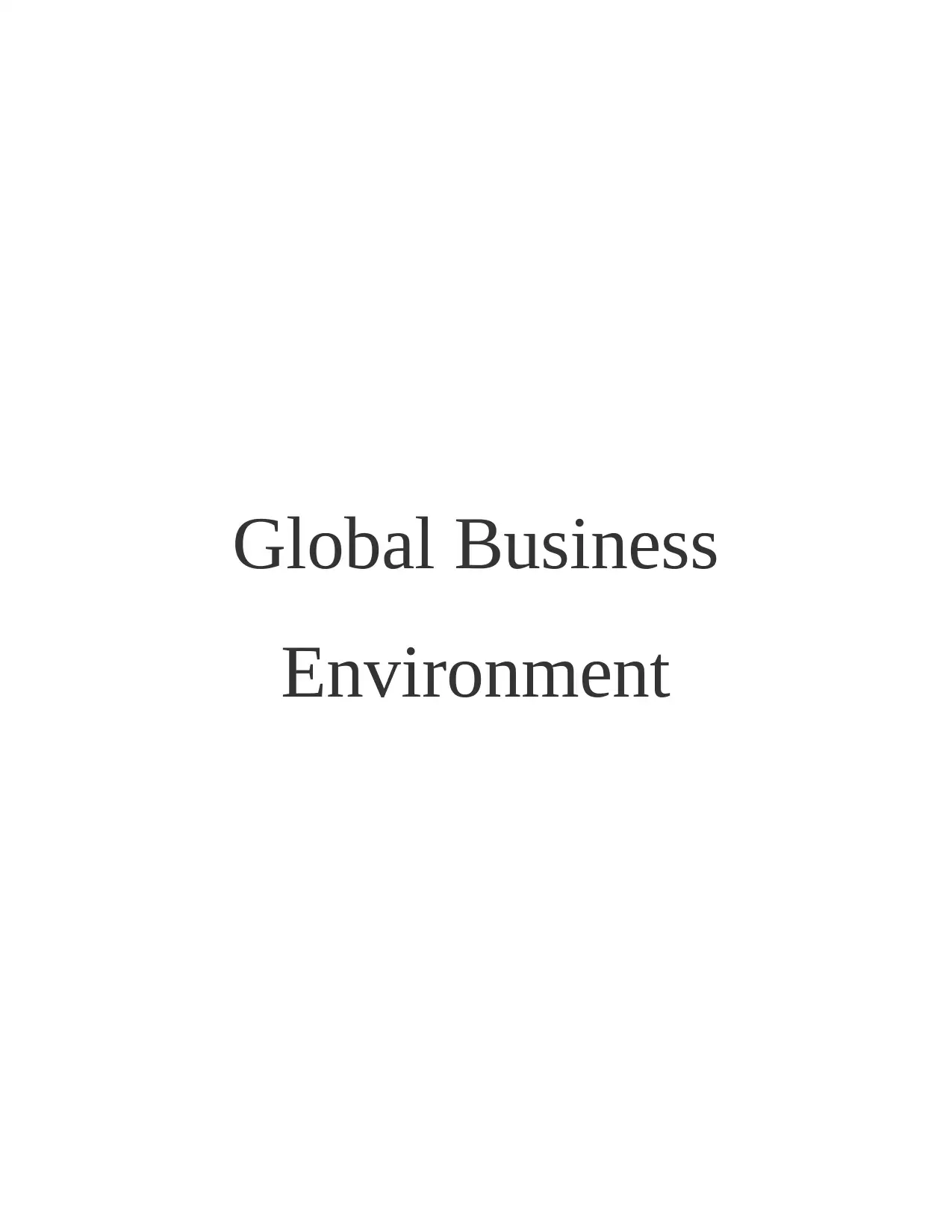
Global Business
Environment
Environment
Secure Best Marks with AI Grader
Need help grading? Try our AI Grader for instant feedback on your assignments.
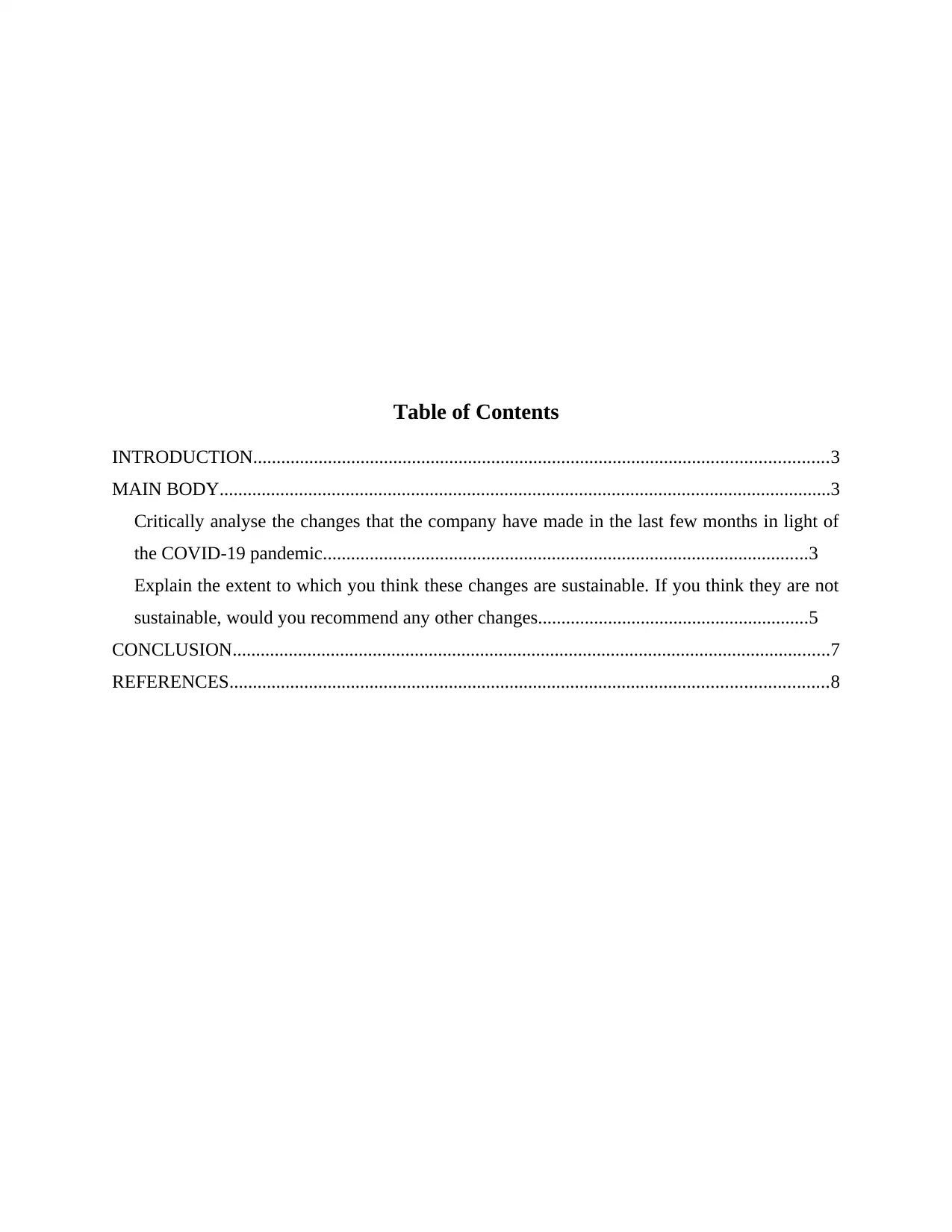
Table of Contents
INTRODUCTION...........................................................................................................................3
MAIN BODY...................................................................................................................................3
Critically analyse the changes that the company have made in the last few months in light of
the COVID-19 pandemic........................................................................................................3
Explain the extent to which you think these changes are sustainable. If you think they are not
sustainable, would you recommend any other changes..........................................................5
CONCLUSION................................................................................................................................7
REFERENCES................................................................................................................................8
INTRODUCTION...........................................................................................................................3
MAIN BODY...................................................................................................................................3
Critically analyse the changes that the company have made in the last few months in light of
the COVID-19 pandemic........................................................................................................3
Explain the extent to which you think these changes are sustainable. If you think they are not
sustainable, would you recommend any other changes..........................................................5
CONCLUSION................................................................................................................................7
REFERENCES................................................................................................................................8


INTRODUCTION
This report helps in understanding the impact of COVID-19 on the global business
environment. As we all know COVID-19 have affected the whole world and it also affected the
lifestyle of the people around the world. It has affected the global business environment by
affecting the business processes and also it affected the profits of every organisation. COVID-19
affected the revenues of the organisation as the consumers stopped going out for shopping and
also the social distancing guidelines which was implemented by the government of every
country. This virus spreads when an healthy person comes in the contact with the infected person
so it affected the people perception about going out and now they avoid going out as much a
possible. The company we are taking in this report is TESCO. TESCO is one of the leading
supermarket chain in UK. This report will help in understand that how the business of TESCO is
affected by the COVID-19 and what changes they made and applied in order to stabilize their
business. TESCO is focusing on their strategies and making changes in these strategies according
to the need of the business.
MAIN BODY
Critically analyse the changes that the company have made in the last few months in light of the
COVID-19 pandemic.
Managers and CEO of companies are facing the challenges and impacts of COVID-19 on
the business and in order to overcome these challenges different steps have been taken. These
days managers are setting up the new cost structures, changing production and operations
process, focusing on efficient use of resources etc. Managers of TESCO have taken different
steps towards tackling this pandemic (Akpan, Udoh and Adebisi, 2020). TESCO is one of the top
supermarket chain in the UK which provides quality products to their consumers within
affordable prices. TESCO started delivering products to their customers to their home and also
give the option of contactless delivery which makes ensures the consumers safety. TESCO have
their online shopping portal by which consumers can order their products from home and get
their products at their home. TESCO started giving exciting offers to their consumers amid this
pandemic which motivates the consumers to buy in bulk quantity and by this TESCO is covering
their losses which was incurred to them due to this pandemic (Bretas and Alon, 2020). During
the lock-down amid this pandemic the need of grocery products have increased which made
This report helps in understanding the impact of COVID-19 on the global business
environment. As we all know COVID-19 have affected the whole world and it also affected the
lifestyle of the people around the world. It has affected the global business environment by
affecting the business processes and also it affected the profits of every organisation. COVID-19
affected the revenues of the organisation as the consumers stopped going out for shopping and
also the social distancing guidelines which was implemented by the government of every
country. This virus spreads when an healthy person comes in the contact with the infected person
so it affected the people perception about going out and now they avoid going out as much a
possible. The company we are taking in this report is TESCO. TESCO is one of the leading
supermarket chain in UK. This report will help in understand that how the business of TESCO is
affected by the COVID-19 and what changes they made and applied in order to stabilize their
business. TESCO is focusing on their strategies and making changes in these strategies according
to the need of the business.
MAIN BODY
Critically analyse the changes that the company have made in the last few months in light of the
COVID-19 pandemic.
Managers and CEO of companies are facing the challenges and impacts of COVID-19 on
the business and in order to overcome these challenges different steps have been taken. These
days managers are setting up the new cost structures, changing production and operations
process, focusing on efficient use of resources etc. Managers of TESCO have taken different
steps towards tackling this pandemic (Akpan, Udoh and Adebisi, 2020). TESCO is one of the top
supermarket chain in the UK which provides quality products to their consumers within
affordable prices. TESCO started delivering products to their customers to their home and also
give the option of contactless delivery which makes ensures the consumers safety. TESCO have
their online shopping portal by which consumers can order their products from home and get
their products at their home. TESCO started giving exciting offers to their consumers amid this
pandemic which motivates the consumers to buy in bulk quantity and by this TESCO is covering
their losses which was incurred to them due to this pandemic (Bretas and Alon, 2020). During
the lock-down amid this pandemic the need of grocery products have increased which made
Secure Best Marks with AI Grader
Need help grading? Try our AI Grader for instant feedback on your assignments.
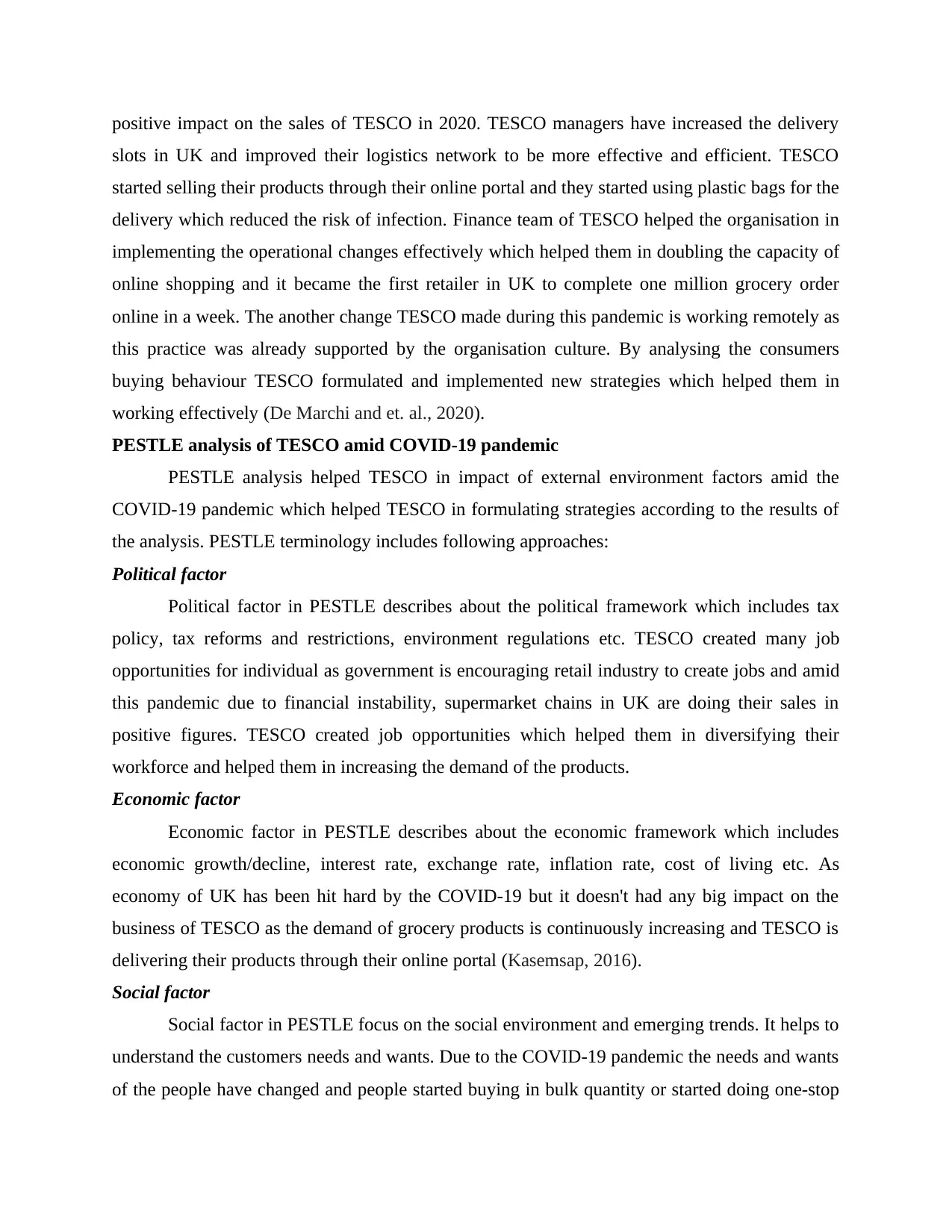
positive impact on the sales of TESCO in 2020. TESCO managers have increased the delivery
slots in UK and improved their logistics network to be more effective and efficient. TESCO
started selling their products through their online portal and they started using plastic bags for the
delivery which reduced the risk of infection. Finance team of TESCO helped the organisation in
implementing the operational changes effectively which helped them in doubling the capacity of
online shopping and it became the first retailer in UK to complete one million grocery order
online in a week. The another change TESCO made during this pandemic is working remotely as
this practice was already supported by the organisation culture. By analysing the consumers
buying behaviour TESCO formulated and implemented new strategies which helped them in
working effectively (De Marchi and et. al., 2020).
PESTLE analysis of TESCO amid COVID-19 pandemic
PESTLE analysis helped TESCO in impact of external environment factors amid the
COVID-19 pandemic which helped TESCO in formulating strategies according to the results of
the analysis. PESTLE terminology includes following approaches:
Political factor
Political factor in PESTLE describes about the political framework which includes tax
policy, tax reforms and restrictions, environment regulations etc. TESCO created many job
opportunities for individual as government is encouraging retail industry to create jobs and amid
this pandemic due to financial instability, supermarket chains in UK are doing their sales in
positive figures. TESCO created job opportunities which helped them in diversifying their
workforce and helped them in increasing the demand of the products.
Economic factor
Economic factor in PESTLE describes about the economic framework which includes
economic growth/decline, interest rate, exchange rate, inflation rate, cost of living etc. As
economy of UK has been hit hard by the COVID-19 but it doesn't had any big impact on the
business of TESCO as the demand of grocery products is continuously increasing and TESCO is
delivering their products through their online portal (Kasemsap, 2016).
Social factor
Social factor in PESTLE focus on the social environment and emerging trends. It helps to
understand the customers needs and wants. Due to the COVID-19 pandemic the needs and wants
of the people have changed and people started buying in bulk quantity or started doing one-stop
slots in UK and improved their logistics network to be more effective and efficient. TESCO
started selling their products through their online portal and they started using plastic bags for the
delivery which reduced the risk of infection. Finance team of TESCO helped the organisation in
implementing the operational changes effectively which helped them in doubling the capacity of
online shopping and it became the first retailer in UK to complete one million grocery order
online in a week. The another change TESCO made during this pandemic is working remotely as
this practice was already supported by the organisation culture. By analysing the consumers
buying behaviour TESCO formulated and implemented new strategies which helped them in
working effectively (De Marchi and et. al., 2020).
PESTLE analysis of TESCO amid COVID-19 pandemic
PESTLE analysis helped TESCO in impact of external environment factors amid the
COVID-19 pandemic which helped TESCO in formulating strategies according to the results of
the analysis. PESTLE terminology includes following approaches:
Political factor
Political factor in PESTLE describes about the political framework which includes tax
policy, tax reforms and restrictions, environment regulations etc. TESCO created many job
opportunities for individual as government is encouraging retail industry to create jobs and amid
this pandemic due to financial instability, supermarket chains in UK are doing their sales in
positive figures. TESCO created job opportunities which helped them in diversifying their
workforce and helped them in increasing the demand of the products.
Economic factor
Economic factor in PESTLE describes about the economic framework which includes
economic growth/decline, interest rate, exchange rate, inflation rate, cost of living etc. As
economy of UK has been hit hard by the COVID-19 but it doesn't had any big impact on the
business of TESCO as the demand of grocery products is continuously increasing and TESCO is
delivering their products through their online portal (Kasemsap, 2016).
Social factor
Social factor in PESTLE focus on the social environment and emerging trends. It helps to
understand the customers needs and wants. Due to the COVID-19 pandemic the needs and wants
of the people have changed and people started buying in bulk quantity or started doing one-stop
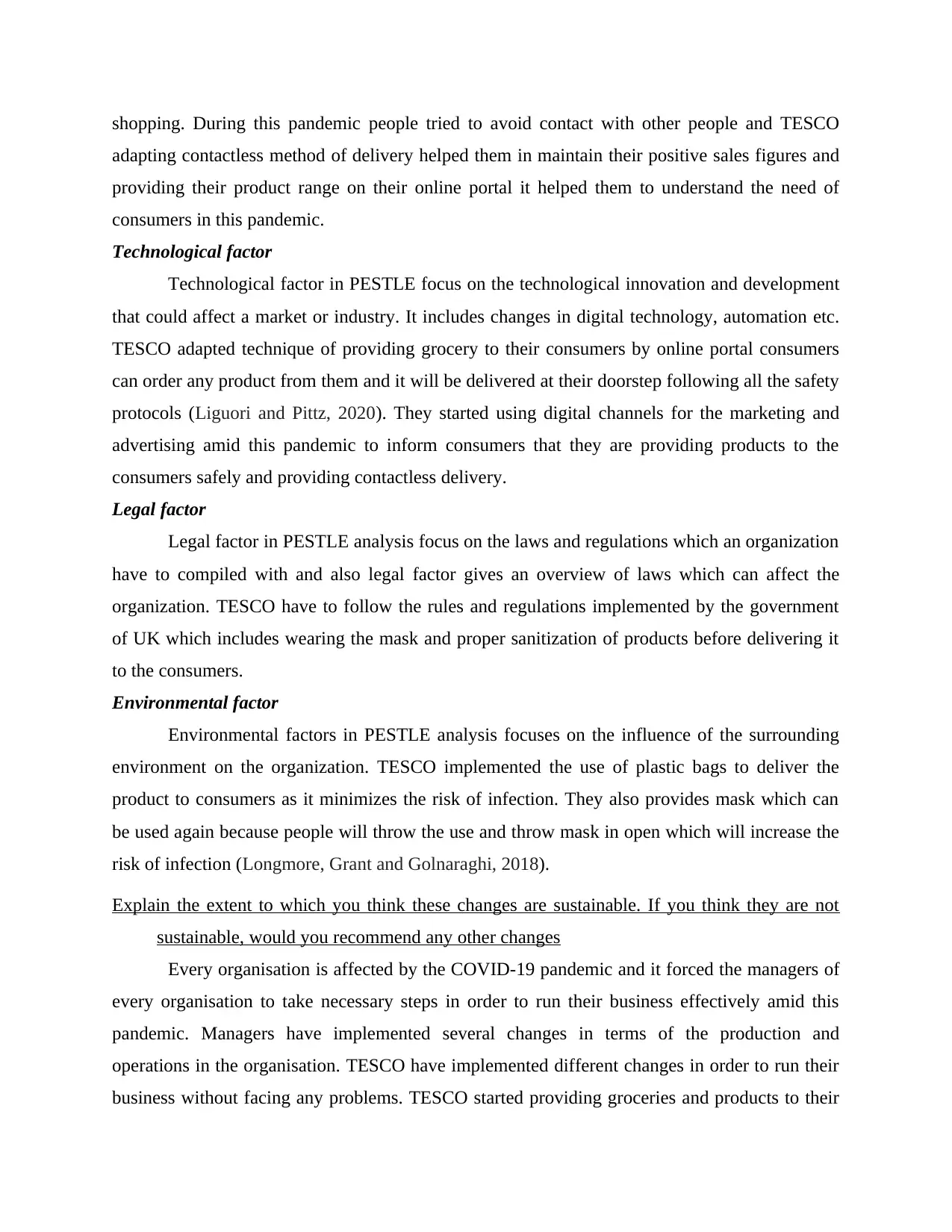
shopping. During this pandemic people tried to avoid contact with other people and TESCO
adapting contactless method of delivery helped them in maintain their positive sales figures and
providing their product range on their online portal it helped them to understand the need of
consumers in this pandemic.
Technological factor
Technological factor in PESTLE focus on the technological innovation and development
that could affect a market or industry. It includes changes in digital technology, automation etc.
TESCO adapted technique of providing grocery to their consumers by online portal consumers
can order any product from them and it will be delivered at their doorstep following all the safety
protocols (Liguori and Pittz, 2020). They started using digital channels for the marketing and
advertising amid this pandemic to inform consumers that they are providing products to the
consumers safely and providing contactless delivery.
Legal factor
Legal factor in PESTLE analysis focus on the laws and regulations which an organization
have to compiled with and also legal factor gives an overview of laws which can affect the
organization. TESCO have to follow the rules and regulations implemented by the government
of UK which includes wearing the mask and proper sanitization of products before delivering it
to the consumers.
Environmental factor
Environmental factors in PESTLE analysis focuses on the influence of the surrounding
environment on the organization. TESCO implemented the use of plastic bags to deliver the
product to consumers as it minimizes the risk of infection. They also provides mask which can
be used again because people will throw the use and throw mask in open which will increase the
risk of infection (Longmore, Grant and Golnaraghi, 2018).
Explain the extent to which you think these changes are sustainable. If you think they are not
sustainable, would you recommend any other changes
Every organisation is affected by the COVID-19 pandemic and it forced the managers of
every organisation to take necessary steps in order to run their business effectively amid this
pandemic. Managers have implemented several changes in terms of the production and
operations in the organisation. TESCO have implemented different changes in order to run their
business without facing any problems. TESCO started providing groceries and products to their
adapting contactless method of delivery helped them in maintain their positive sales figures and
providing their product range on their online portal it helped them to understand the need of
consumers in this pandemic.
Technological factor
Technological factor in PESTLE focus on the technological innovation and development
that could affect a market or industry. It includes changes in digital technology, automation etc.
TESCO adapted technique of providing grocery to their consumers by online portal consumers
can order any product from them and it will be delivered at their doorstep following all the safety
protocols (Liguori and Pittz, 2020). They started using digital channels for the marketing and
advertising amid this pandemic to inform consumers that they are providing products to the
consumers safely and providing contactless delivery.
Legal factor
Legal factor in PESTLE analysis focus on the laws and regulations which an organization
have to compiled with and also legal factor gives an overview of laws which can affect the
organization. TESCO have to follow the rules and regulations implemented by the government
of UK which includes wearing the mask and proper sanitization of products before delivering it
to the consumers.
Environmental factor
Environmental factors in PESTLE analysis focuses on the influence of the surrounding
environment on the organization. TESCO implemented the use of plastic bags to deliver the
product to consumers as it minimizes the risk of infection. They also provides mask which can
be used again because people will throw the use and throw mask in open which will increase the
risk of infection (Longmore, Grant and Golnaraghi, 2018).
Explain the extent to which you think these changes are sustainable. If you think they are not
sustainable, would you recommend any other changes
Every organisation is affected by the COVID-19 pandemic and it forced the managers of
every organisation to take necessary steps in order to run their business effectively amid this
pandemic. Managers have implemented several changes in terms of the production and
operations in the organisation. TESCO have implemented different changes in order to run their
business without facing any problems. TESCO started providing groceries and products to their
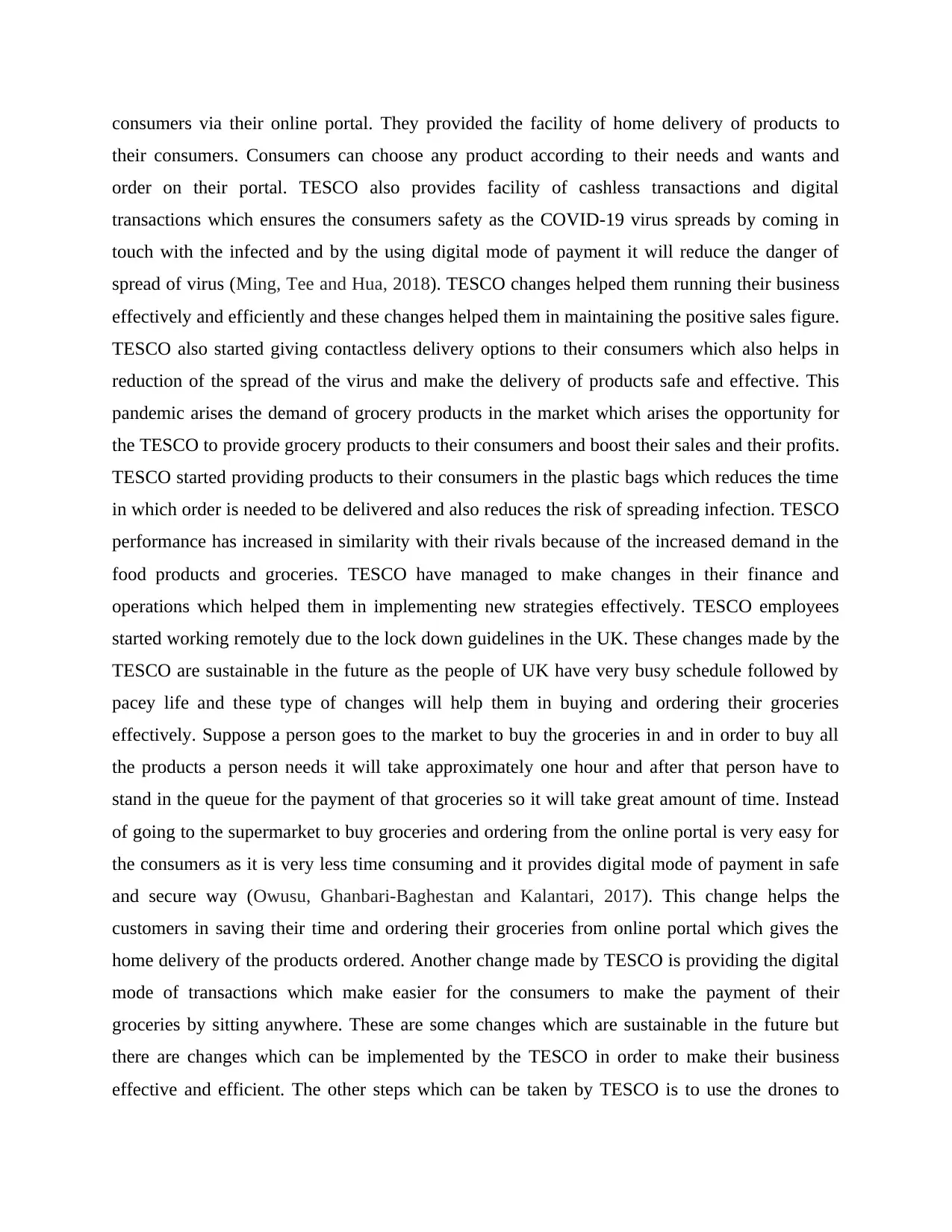
consumers via their online portal. They provided the facility of home delivery of products to
their consumers. Consumers can choose any product according to their needs and wants and
order on their portal. TESCO also provides facility of cashless transactions and digital
transactions which ensures the consumers safety as the COVID-19 virus spreads by coming in
touch with the infected and by the using digital mode of payment it will reduce the danger of
spread of virus (Ming, Tee and Hua, 2018). TESCO changes helped them running their business
effectively and efficiently and these changes helped them in maintaining the positive sales figure.
TESCO also started giving contactless delivery options to their consumers which also helps in
reduction of the spread of the virus and make the delivery of products safe and effective. This
pandemic arises the demand of grocery products in the market which arises the opportunity for
the TESCO to provide grocery products to their consumers and boost their sales and their profits.
TESCO started providing products to their consumers in the plastic bags which reduces the time
in which order is needed to be delivered and also reduces the risk of spreading infection. TESCO
performance has increased in similarity with their rivals because of the increased demand in the
food products and groceries. TESCO have managed to make changes in their finance and
operations which helped them in implementing new strategies effectively. TESCO employees
started working remotely due to the lock down guidelines in the UK. These changes made by the
TESCO are sustainable in the future as the people of UK have very busy schedule followed by
pacey life and these type of changes will help them in buying and ordering their groceries
effectively. Suppose a person goes to the market to buy the groceries in and in order to buy all
the products a person needs it will take approximately one hour and after that person have to
stand in the queue for the payment of that groceries so it will take great amount of time. Instead
of going to the supermarket to buy groceries and ordering from the online portal is very easy for
the consumers as it is very less time consuming and it provides digital mode of payment in safe
and secure way (Owusu, Ghanbari-Baghestan and Kalantari, 2017). This change helps the
customers in saving their time and ordering their groceries from online portal which gives the
home delivery of the products ordered. Another change made by TESCO is providing the digital
mode of transactions which make easier for the consumers to make the payment of their
groceries by sitting anywhere. These are some changes which are sustainable in the future but
there are changes which can be implemented by the TESCO in order to make their business
effective and efficient. The other steps which can be taken by TESCO is to use the drones to
their consumers. Consumers can choose any product according to their needs and wants and
order on their portal. TESCO also provides facility of cashless transactions and digital
transactions which ensures the consumers safety as the COVID-19 virus spreads by coming in
touch with the infected and by the using digital mode of payment it will reduce the danger of
spread of virus (Ming, Tee and Hua, 2018). TESCO changes helped them running their business
effectively and efficiently and these changes helped them in maintaining the positive sales figure.
TESCO also started giving contactless delivery options to their consumers which also helps in
reduction of the spread of the virus and make the delivery of products safe and effective. This
pandemic arises the demand of grocery products in the market which arises the opportunity for
the TESCO to provide grocery products to their consumers and boost their sales and their profits.
TESCO started providing products to their consumers in the plastic bags which reduces the time
in which order is needed to be delivered and also reduces the risk of spreading infection. TESCO
performance has increased in similarity with their rivals because of the increased demand in the
food products and groceries. TESCO have managed to make changes in their finance and
operations which helped them in implementing new strategies effectively. TESCO employees
started working remotely due to the lock down guidelines in the UK. These changes made by the
TESCO are sustainable in the future as the people of UK have very busy schedule followed by
pacey life and these type of changes will help them in buying and ordering their groceries
effectively. Suppose a person goes to the market to buy the groceries in and in order to buy all
the products a person needs it will take approximately one hour and after that person have to
stand in the queue for the payment of that groceries so it will take great amount of time. Instead
of going to the supermarket to buy groceries and ordering from the online portal is very easy for
the consumers as it is very less time consuming and it provides digital mode of payment in safe
and secure way (Owusu, Ghanbari-Baghestan and Kalantari, 2017). This change helps the
customers in saving their time and ordering their groceries from online portal which gives the
home delivery of the products ordered. Another change made by TESCO is providing the digital
mode of transactions which make easier for the consumers to make the payment of their
groceries by sitting anywhere. These are some changes which are sustainable in the future but
there are changes which can be implemented by the TESCO in order to make their business
effective and efficient. The other steps which can be taken by TESCO is to use the drones to
Paraphrase This Document
Need a fresh take? Get an instant paraphrase of this document with our AI Paraphraser
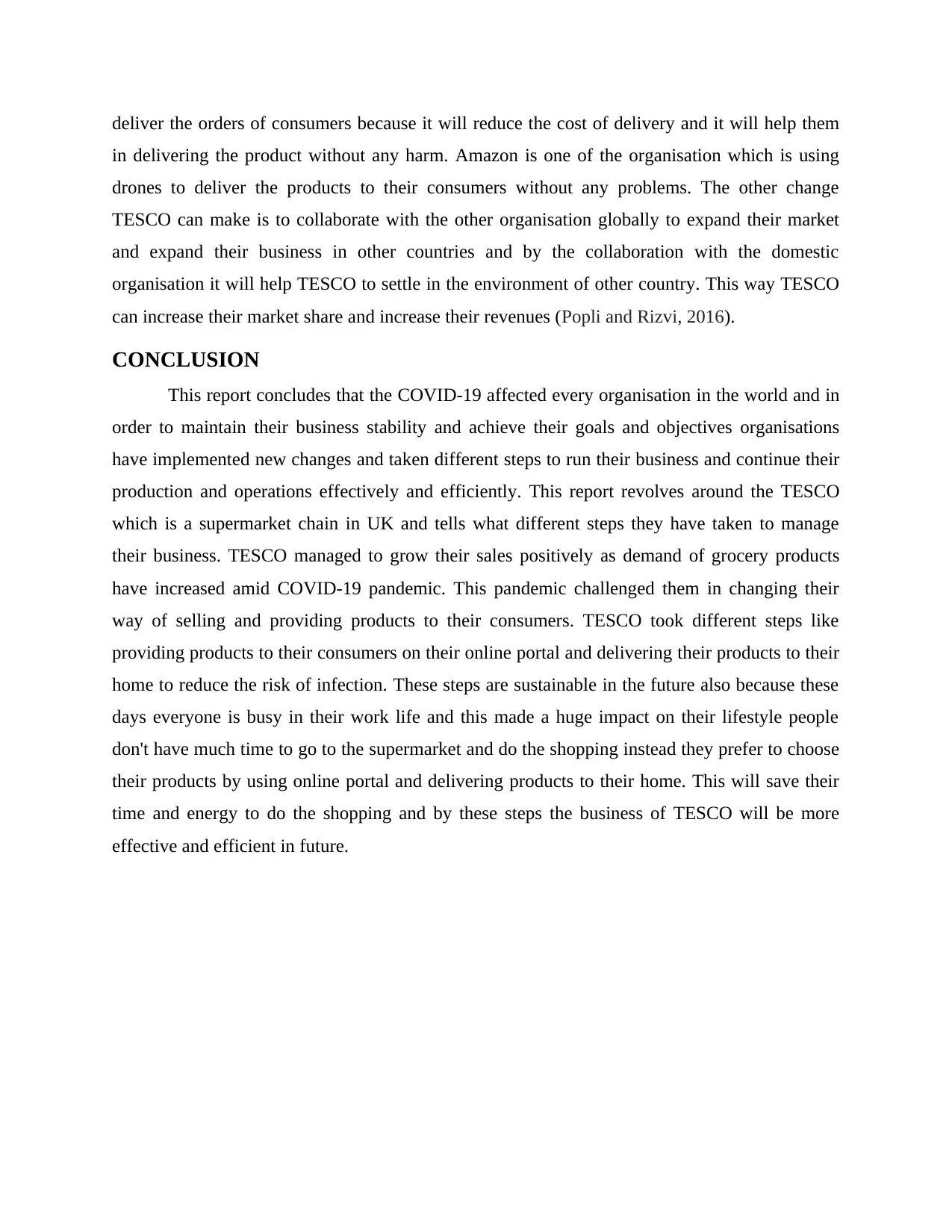
deliver the orders of consumers because it will reduce the cost of delivery and it will help them
in delivering the product without any harm. Amazon is one of the organisation which is using
drones to deliver the products to their consumers without any problems. The other change
TESCO can make is to collaborate with the other organisation globally to expand their market
and expand their business in other countries and by the collaboration with the domestic
organisation it will help TESCO to settle in the environment of other country. This way TESCO
can increase their market share and increase their revenues (Popli and Rizvi, 2016).
CONCLUSION
This report concludes that the COVID-19 affected every organisation in the world and in
order to maintain their business stability and achieve their goals and objectives organisations
have implemented new changes and taken different steps to run their business and continue their
production and operations effectively and efficiently. This report revolves around the TESCO
which is a supermarket chain in UK and tells what different steps they have taken to manage
their business. TESCO managed to grow their sales positively as demand of grocery products
have increased amid COVID-19 pandemic. This pandemic challenged them in changing their
way of selling and providing products to their consumers. TESCO took different steps like
providing products to their consumers on their online portal and delivering their products to their
home to reduce the risk of infection. These steps are sustainable in the future also because these
days everyone is busy in their work life and this made a huge impact on their lifestyle people
don't have much time to go to the supermarket and do the shopping instead they prefer to choose
their products by using online portal and delivering products to their home. This will save their
time and energy to do the shopping and by these steps the business of TESCO will be more
effective and efficient in future.
in delivering the product without any harm. Amazon is one of the organisation which is using
drones to deliver the products to their consumers without any problems. The other change
TESCO can make is to collaborate with the other organisation globally to expand their market
and expand their business in other countries and by the collaboration with the domestic
organisation it will help TESCO to settle in the environment of other country. This way TESCO
can increase their market share and increase their revenues (Popli and Rizvi, 2016).
CONCLUSION
This report concludes that the COVID-19 affected every organisation in the world and in
order to maintain their business stability and achieve their goals and objectives organisations
have implemented new changes and taken different steps to run their business and continue their
production and operations effectively and efficiently. This report revolves around the TESCO
which is a supermarket chain in UK and tells what different steps they have taken to manage
their business. TESCO managed to grow their sales positively as demand of grocery products
have increased amid COVID-19 pandemic. This pandemic challenged them in changing their
way of selling and providing products to their consumers. TESCO took different steps like
providing products to their consumers on their online portal and delivering their products to their
home to reduce the risk of infection. These steps are sustainable in the future also because these
days everyone is busy in their work life and this made a huge impact on their lifestyle people
don't have much time to go to the supermarket and do the shopping instead they prefer to choose
their products by using online portal and delivering products to their home. This will save their
time and energy to do the shopping and by these steps the business of TESCO will be more
effective and efficient in future.
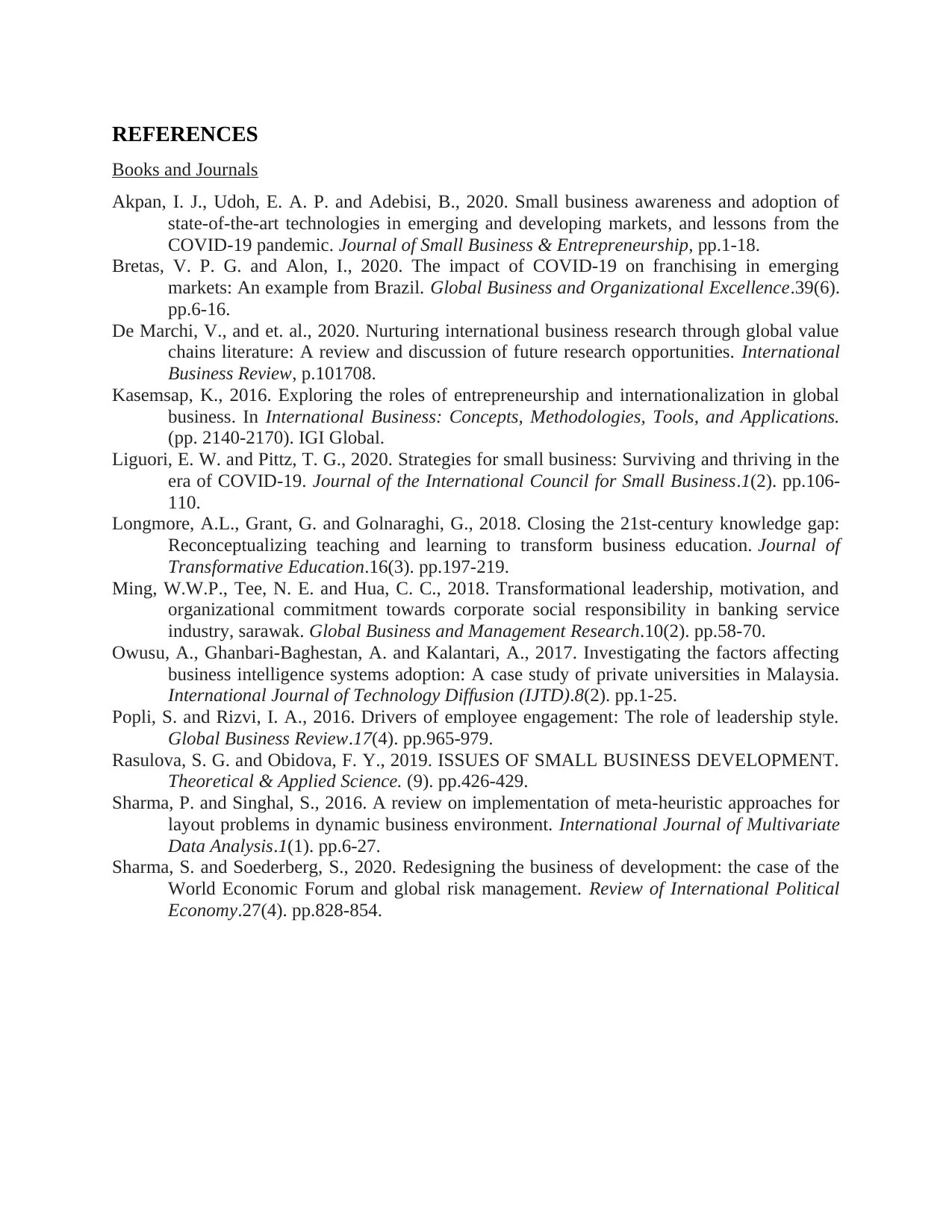
REFERENCES
Books and Journals
Akpan, I. J., Udoh, E. A. P. and Adebisi, B., 2020. Small business awareness and adoption of
state-of-the-art technologies in emerging and developing markets, and lessons from the
COVID-19 pandemic. Journal of Small Business & Entrepreneurship, pp.1-18.
Bretas, V. P. G. and Alon, I., 2020. The impact of COVID‐19 on franchising in emerging
markets: An example from Brazil. Global Business and Organizational Excellence.39(6).
pp.6-16.
De Marchi, V., and et. al., 2020. Nurturing international business research through global value
chains literature: A review and discussion of future research opportunities. International
Business Review, p.101708.
Kasemsap, K., 2016. Exploring the roles of entrepreneurship and internationalization in global
business. In International Business: Concepts, Methodologies, Tools, and Applications.
(pp. 2140-2170). IGI Global.
Liguori, E. W. and Pittz, T. G., 2020. Strategies for small business: Surviving and thriving in the
era of COVID-19. Journal of the International Council for Small Business.1(2). pp.106-
110.
Longmore, A.L., Grant, G. and Golnaraghi, G., 2018. Closing the 21st-century knowledge gap:
Reconceptualizing teaching and learning to transform business education. Journal of
Transformative Education.16(3). pp.197-219.
Ming, W.W.P., Tee, N. E. and Hua, C. C., 2018. Transformational leadership, motivation, and
organizational commitment towards corporate social responsibility in banking service
industry, sarawak. Global Business and Management Research.10(2). pp.58-70.
Owusu, A., Ghanbari-Baghestan, A. and Kalantari, A., 2017. Investigating the factors affecting
business intelligence systems adoption: A case study of private universities in Malaysia.
International Journal of Technology Diffusion (IJTD).8(2). pp.1-25.
Popli, S. and Rizvi, I. A., 2016. Drivers of employee engagement: The role of leadership style.
Global Business Review.17(4). pp.965-979.
Rasulova, S. G. and Obidova, F. Y., 2019. ISSUES OF SMALL BUSINESS DEVELOPMENT.
Theoretical & Applied Science. (9). pp.426-429.
Sharma, P. and Singhal, S., 2016. A review on implementation of meta-heuristic approaches for
layout problems in dynamic business environment. International Journal of Multivariate
Data Analysis.1(1). pp.6-27.
Sharma, S. and Soederberg, S., 2020. Redesigning the business of development: the case of the
World Economic Forum and global risk management. Review of International Political
Economy.27(4). pp.828-854.
Books and Journals
Akpan, I. J., Udoh, E. A. P. and Adebisi, B., 2020. Small business awareness and adoption of
state-of-the-art technologies in emerging and developing markets, and lessons from the
COVID-19 pandemic. Journal of Small Business & Entrepreneurship, pp.1-18.
Bretas, V. P. G. and Alon, I., 2020. The impact of COVID‐19 on franchising in emerging
markets: An example from Brazil. Global Business and Organizational Excellence.39(6).
pp.6-16.
De Marchi, V., and et. al., 2020. Nurturing international business research through global value
chains literature: A review and discussion of future research opportunities. International
Business Review, p.101708.
Kasemsap, K., 2016. Exploring the roles of entrepreneurship and internationalization in global
business. In International Business: Concepts, Methodologies, Tools, and Applications.
(pp. 2140-2170). IGI Global.
Liguori, E. W. and Pittz, T. G., 2020. Strategies for small business: Surviving and thriving in the
era of COVID-19. Journal of the International Council for Small Business.1(2). pp.106-
110.
Longmore, A.L., Grant, G. and Golnaraghi, G., 2018. Closing the 21st-century knowledge gap:
Reconceptualizing teaching and learning to transform business education. Journal of
Transformative Education.16(3). pp.197-219.
Ming, W.W.P., Tee, N. E. and Hua, C. C., 2018. Transformational leadership, motivation, and
organizational commitment towards corporate social responsibility in banking service
industry, sarawak. Global Business and Management Research.10(2). pp.58-70.
Owusu, A., Ghanbari-Baghestan, A. and Kalantari, A., 2017. Investigating the factors affecting
business intelligence systems adoption: A case study of private universities in Malaysia.
International Journal of Technology Diffusion (IJTD).8(2). pp.1-25.
Popli, S. and Rizvi, I. A., 2016. Drivers of employee engagement: The role of leadership style.
Global Business Review.17(4). pp.965-979.
Rasulova, S. G. and Obidova, F. Y., 2019. ISSUES OF SMALL BUSINESS DEVELOPMENT.
Theoretical & Applied Science. (9). pp.426-429.
Sharma, P. and Singhal, S., 2016. A review on implementation of meta-heuristic approaches for
layout problems in dynamic business environment. International Journal of Multivariate
Data Analysis.1(1). pp.6-27.
Sharma, S. and Soederberg, S., 2020. Redesigning the business of development: the case of the
World Economic Forum and global risk management. Review of International Political
Economy.27(4). pp.828-854.
1 out of 9
Related Documents
Your All-in-One AI-Powered Toolkit for Academic Success.
+13062052269
info@desklib.com
Available 24*7 on WhatsApp / Email
![[object Object]](/_next/static/media/star-bottom.7253800d.svg)
Unlock your academic potential
© 2024 | Zucol Services PVT LTD | All rights reserved.





